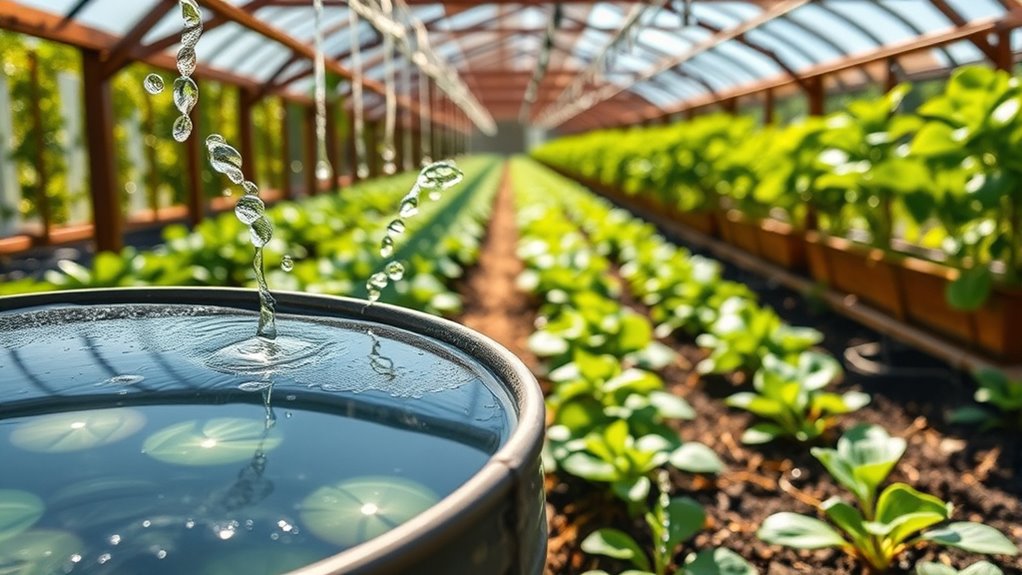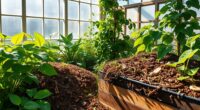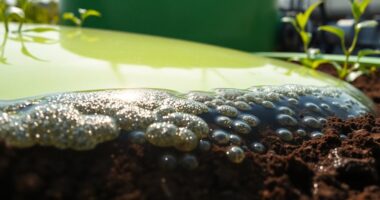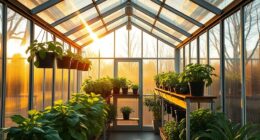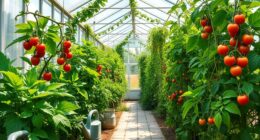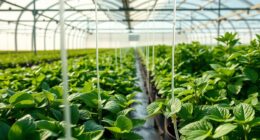To conserve water in your greenhouse, consider using drip irrigation systems that deliver water directly to plant roots, minimizing waste. Rainwater harvesting collects free water, reducing reliance on municipal supplies. Incorporate advanced technologies like precision monitoring and smart systems to optimize water usage. Efficient irrigation techniques and thoughtful greenhouse design can also enhance water efficiency. Explore these techniques further to ensure a thriving, sustainable greenhouse environment.
Key Takeaways
- Implement drip irrigation systems to deliver water directly to plant roots, minimizing waste and promoting healthy root development.
- Utilize rainwater harvesting to collect free, soft water from roofs, reducing reliance on municipal supplies.
- Incorporate advanced technologies like precision monitoring systems and smart greenhouse technology to optimize water usage efficiently.
- Design greenhouses with proper insulation and glazing to minimize evaporation and maintain stable temperatures.
- Regularly monitor and maintain irrigation systems to detect leaks and ensure optimal soil moisture levels.
Drip Irrigation Systems for Efficient Water Use
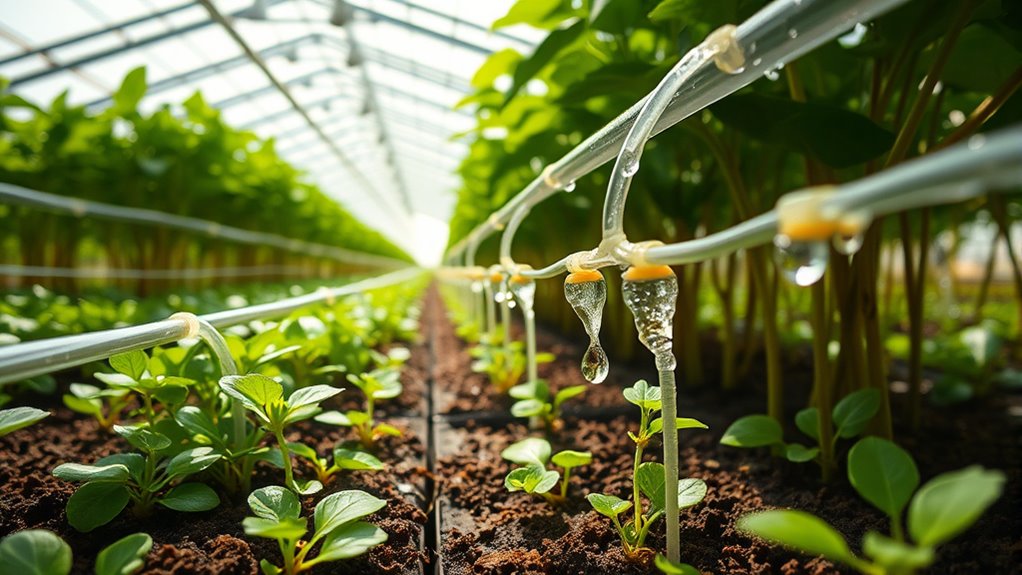
When you implement a drip irrigation system in your greenhouse, you’re choosing one of the most efficient methods for water conservation. This system delivers water directly to the roots, minimizing evaporation and runoff.
While the initial costs might be higher, installation and maintenance are straightforward. You’ll notice healthier plants, as direct watering promotes robust root development and reduces leaf diseases caused by excessive moisture.
Plus, drip systems are scalable, fitting greenhouses of any size, and can be easily automated for precise watering. Key components like filters, pressure regulators, and timers ensure optimal performance.
Rainwater Harvesting Methods

Implementing efficient water conservation methods in your greenhouse goes beyond drip irrigation systems.
Rainwater harvesting offers a cost-effective solution, allowing you to collect free water right from your roof. By installing gutters and downspouts, you can direct rainwater into storage tanks, ensuring you have a reliable water source. This water is naturally soft and chemical-free, promoting healthier plant growth.
Rainwater harvesting is an eco-friendly, cost-effective way to collect soft, chemical-free water for thriving plants.
You’ll also reduce strain on municipal supplies, supporting sustainable practices. Setting up a rainwater harvesting system requires minimal maintenance, and many states provide tax incentives to encourage these projects.
Just remember to monitor water quality and ensure proper filtration to keep your plants thriving. Embrace this eco-friendly method and watch your greenhouse flourish!
Advanced Technologies in Water Conservation
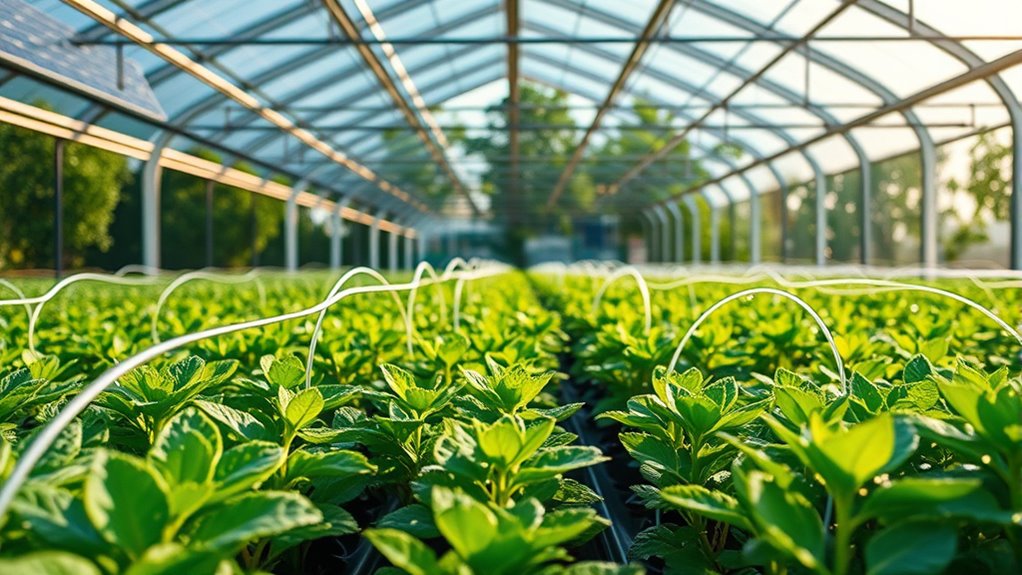
As greenhouse technology evolves, advanced water conservation methods are becoming essential for optimizing resource use and promoting sustainability.
You can leverage precision monitoring systems that adjust environmental conditions in real-time, reducing unnecessary water consumption. Dehumidification systems extract moisture from the air, allowing you to collect and reuse significant amounts of water daily.
Smart greenhouse technology automates processes, cutting water usage by nearly 98% compared to traditional methods. Vertical hydroponic systems recirculate water and nutrients, maximizing space and minimizing waste.
Additionally, advancements like sorption-based atmosphere water harvesting and superabsorbent polymers promise future water-saving strategies.
Efficient Irrigation Techniques
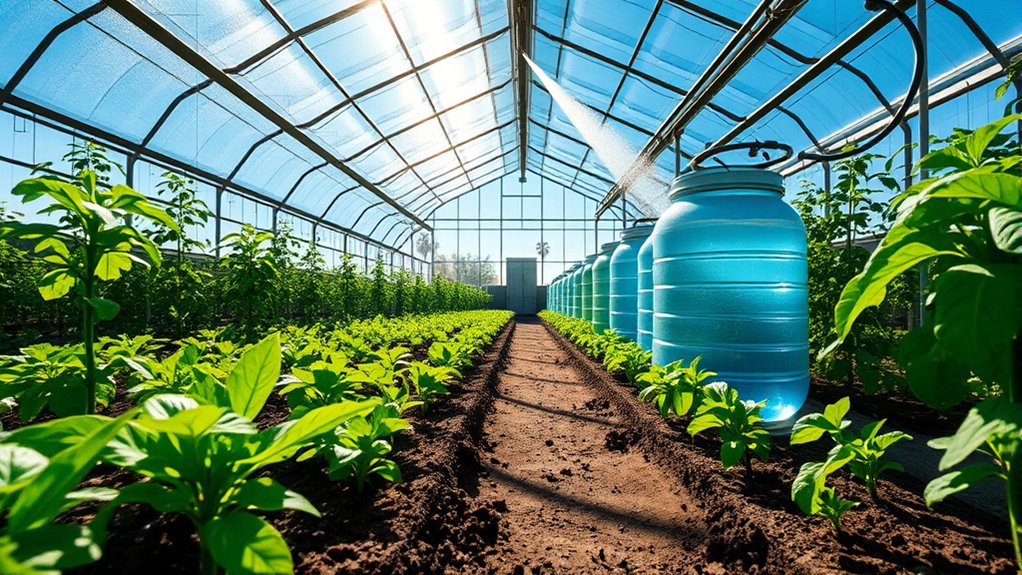
To maximize water efficiency in your greenhouse, adopting efficient irrigation techniques is crucial.
Drip irrigation delivers water directly to plant roots, minimizing evaporation and runoff. Consider micro-sprinkler systems for uniform coverage, especially for crops needing foliar moisture. Subirrigation conserves water and nutrients by supplying them from the bottom of containers, while pipeline irrigation is straightforward to maintain for smaller setups.
Efficient irrigation methods, like drip and subirrigation, ensure optimal water delivery while reducing waste and enhancing nutrient retention.
For larger greenhouses, mobile overhead sprinklers offer flexibility.
Optimize your watering schedule by using moisture sensors and digital controllers to adjust based on real-time needs. Regular maintenance keeps systems unclogged, and monitoring your water usage helps identify inefficiencies.
Greenhouse Design for Water Efficiency

Designing a greenhouse with water efficiency in mind not only conserves this vital resource but also creates an optimal environment for plant growth. Proper insulation minimizes evaporation and maintains stable temperatures, while glass or polycarbonate glazing reduces solar radiation, lowering evapotranspiration rates.
Implementing effective shading systems can further control radiation exposure. Utilize ventilation systems to manage air movement, which directly affects moisture loss.
Choose plants wisely; closer spacing and grouping those with similar water needs optimize irrigation. Incorporate rainwater harvesting with gutters and UV-resistant storage tanks to collect and reuse water efficiently.
Regular monitoring and maintenance of irrigation systems will help you detect leaks and maintain ideal soil moisture levels, maximizing your greenhouse’s water conservation efforts.
Best Practices for Water Management
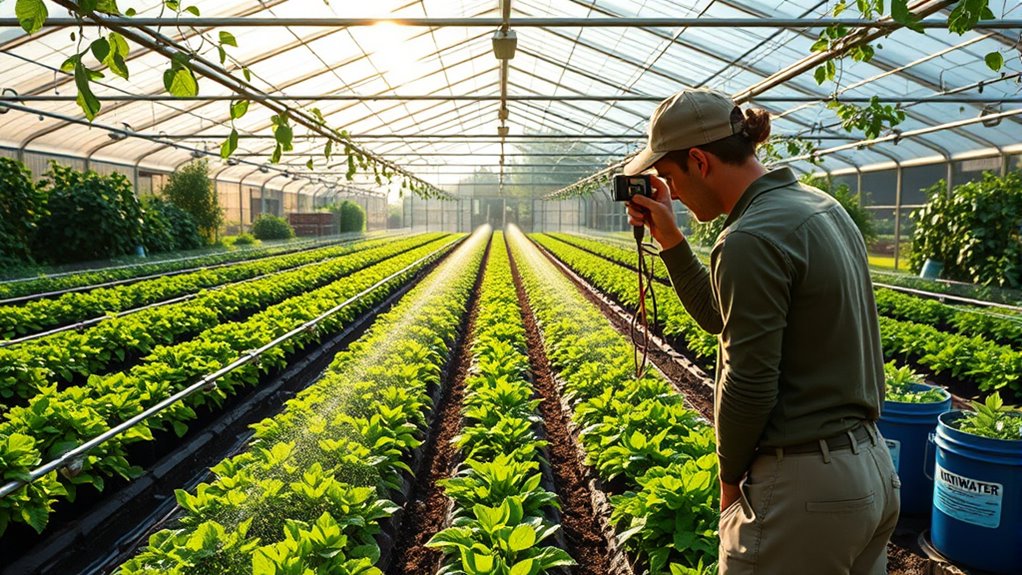
An efficient greenhouse design lays the groundwork for effective water management practices that can significantly enhance sustainability.
Start by utilizing rainwater as your primary source; its purity and sustainability make it ideal. Supplement with groundwater or tap water when necessary, ensuring it meets hydroponic standards.
Implement closed hydroponic systems to recycle drain water, which can reduce water consumption by 20-40%. Use drip irrigation to deliver water directly to roots, minimizing evaporation and runoff.
Automate irrigation with sensors to optimize delivery based on plant needs and climate data. Regularly test water quality and analyze usage trends to adjust your strategies effectively.
Frequently Asked Questions
How Can I Choose Drought-Resistant Plants for My Greenhouse?
When choosing drought-resistant plants for your greenhouse, focus on native species adapted to dry climates.
Look for succulents like Echeveria and Agave, or Mediterranean plants such as Lavender and Rosemary.
Consider plants with deep root systems, like prairie grasses, which can access moisture below the surface.
Opt for perennials like Yarrow and low-maintenance trees like Coast Live Oak.
These selections will thrive while requiring less water, making them ideal for your greenhouse.
What Are the Signs of Overwatering in Greenhouse Plants?
You’ll notice signs of overwatering in your greenhouse plants through yellowing leaves, wilting, or mushy stems.
If you see leaf drop or fungal growth on the soil’s surface, it’s time to act. Overwatered roots can’t access oxygen, leading to root health issues.
Regularly check soil moisture and adjust your watering schedule to prevent these problems.
How Often Should I Inspect My Irrigation System for Leaks?
You should inspect your irrigation system for leaks at least twice a year, ideally before spring and after fall.
Regular monitoring is also essential; keep an eye out for any visible leaks or pressure changes.
Adjust your irrigation schedules seasonally to match weather conditions and plant needs.
If possible, consider hiring a professional for an audit to uncover hidden issues and optimize your system’s performance.
Regular inspections save water and money in the long run.
Can I Use Mulch to Reduce Water Evaporation in My Greenhouse?
Oh sure, you don’t want to use mulch to cut down on water evaporation, right?
But if you’re looking for a way to keep your soil moist and support your plants, mulch is your friend!
It shields the soil from sunlight, keeps temperatures stable, and reduces evaporation.
Plus, organic options enrich the soil as they decompose.
So, why not give mulch a shot?
It’s a simple, effective solution for your watering woes!
What Impact Does Climate Change Have on Greenhouse Water Needs?
Climate change significantly affects your greenhouse water needs.
You’ll notice increased droughts and heatwaves, leading to higher water demand as temperatures rise. Erratic rainfall patterns can complicate your water management strategies, making it crucial to adapt.
As water scarcity worsens, you might struggle to maintain optimal conditions for your plants. To combat this, you’ll need to implement more resilient methods to ensure efficient water use and sustain your greenhouse operations effectively.
Conclusion
By implementing these water conservation techniques in your greenhouse, you’re not just saving water; you’re nurturing a thriving ecosystem, like tending to a garden of possibilities. From drip irrigation to rainwater harvesting, each method plays a crucial role in creating a sustainable environment. Remember, efficient water management isn’t just a practice—it’s a mindset. Embrace these strategies, and watch your plants flourish while you contribute to a greener planet. Your efforts today can make a world of difference tomorrow!
